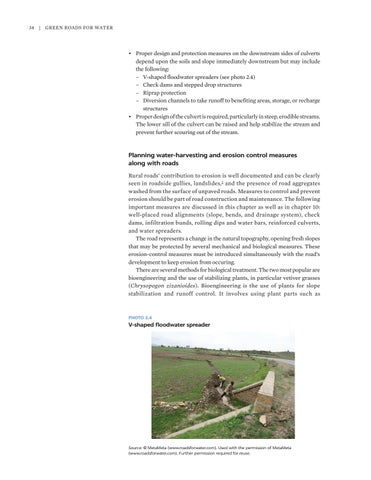34 | Green Roads for WatER
• Proper design and protection measures on the downstream sides of culverts depend upon the soils and slope immediately downstream but may include the following: –– V-shaped floodwater spreaders (see photo 2.4) –– Check dams and stepped drop structures –– Riprap protection –– Diversion channels to take runoff to benefiting areas, storage, or recharge structures • Proper design of the culvert is required, particularly in steep, erodible streams. The lower sill of the culvert can be raised and help stabilize the stream and prevent further scouring out of the stream.
Planning water-harvesting and erosion control measures along with roads Rural roads’ contribution to erosion is well documented and can be clearly seen in roadside gullies, landslides,2 and the presence of road aggregates washed from the surface of unpaved roads. Measures to control and prevent erosion should be part of road construction and maintenance. The following important measures are discussed in this chapter as well as in chapter 10: well-placed road alignments (slope, bends, and drainage system), check dams, infiltration bunds, rolling dips and water bars, reinforced culverts, and water spreaders. The road represents a change in the natural topography, opening fresh slopes that may be protected by several mechanical and biological measures. These erosion-control measures must be introduced simultaneously with the road’s development to keep erosion from occuring. There are several methods for biological treatment. The two most popular are bioengineering and the use of stabilizing plants, in particular vetiver grasses (Chrysopogon zizanioides). Bioengineering is the use of plants for slope stabilization and runoff control. It involves using plant parts such as
PHOTO 2.4
V-shaped floodwater spreader
Source: © MetaMeta (www.roadsforwater.com). Used with the permission of MetaMeta (www.roadsforwater.com). Further permission required for reuse.







































